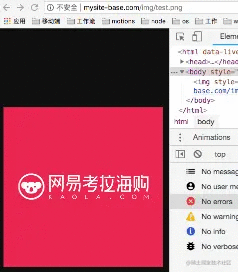你不知道的nginx
你不知道的nginx
参考来源
原文地址
location的匹配规则
- = 表示精确匹配。只有请求的url路径与后面的字符串完全相等时,才会命中。
- ^~ 表示如果该符号后面的字符是最佳匹配,采用该规则,不再进行后续的查找。
- ~ 表示该规则是使用正则定义的,区分大小写。
- ~* 表示该规则是使用正则定义的,不区分大小写。
注意的是,nginx的匹配优先顺序按照上面的顺序进行优先匹配,而且注意的是一旦某一个匹配命中直接退出,不再进行往下的匹配
剩下的普通匹配会按照最长匹配长度优先级来匹配,就是谁匹配的越多就用谁。
server {
server_name website.com;
location /document {
return 701;
}
location ~* ^/docume.*$ {
return 702;
}
location ~* ^/document$ {
return 703;
}
}
curl -I website.com:8080/document 702
# 匹配702 因为正则的优先级更高,而且正则是一旦匹配到就直接退出 所以不会再匹配703server {
server_name website.com;
location ~* ^/docume.*$ {
return 701;
}
location ^~ /doc {
return 702;
}
location ~* ^/document$ {
return 703;
}
}
curl http://website.com/document
HTTP/1.1 702
# 匹配702 因为 ^~精确匹配的优先级比正则高 也是匹配到之后支持退出server {
server_name website.com;
location /doc {
return 702;
}
location /docu {
return 701;
}
}
# 701 前缀匹配匹配是按照最长匹配,跟顺序无关history模式、跨域、缓存、反向代理
# html设置history模式
location / {
index index.html index.htm;
proxy_set_header Host $host;
# history模式最重要就是这里
try_files $uri $uri/ /index.html;
# index.html文件不可以设置强缓存 设置协商缓存即可
add_header Cache-Control 'no-cache, must-revalidate, proxy-revalidate, max-age=0';
}
# 接口反向代理
location ^~ /api/ {
# 跨域处理 设置头部域名
add_header Access-Control-Allow-Origin *;
# 跨域处理 设置头部方法
add_header Access-Control-Allow-Methods 'GET,POST,DELETE,OPTIONS,HEAD';
add_header Access-Control-Allow-Headers 'keep-alive,user-agent,x-requested-with,cache-control,content-type';
if ($request_method = 'options') {
return 204;
}
# 改写路径
rewrite ^/api/(.*)$ /$1 break;
# 反向代理
proxy_set_header Host $host;
proxy_set_header X-Real-IP $remote_addr;
proxy_set_header REMOTE-HOST $remote_addr;
proxy_set_header X-Forwarded-For $proxy_add_x_forwarded_for;
proxy_pass http://static_env;
}
location ~* \.(?:css(\.map)?|js(\.map)?|gif|svg|jfif|ico|cur|heic|webp|tiff?|mp3|m4a|aac|ogg|midi?|wav|mp4|mov|webm|mpe?g|avi|ogv|flv|wmv)$ {
# 静态资源设置七天强缓存
expires 7d;
access_log off;
}快速实现简单的访问限制
location / {
deny 192.168.1.100;
allow 192.168.1.10/200;
allow 10.110.50.16;
deny all;
}解决跨域 的另一个方法
#请求跨域,这里约定代理请求url path是以/apis/开头
location ^~/apis/ {
# 这里重写了请求,将正则匹配中的第一个()中$1的path,拼接到真正的请求后面,并用break停止后续匹配
rewrite ^/apis/(.*)$ /$1 break;
proxy_pass https://www.kaola.com/;
}在页面代码里,把请求url换成http://xxx.com/apis/xxx.html 。这样就可以正常请求到数据
适配PC与移动环境
存在PC站和H5站两个站点,根据用户的浏览环境自动切换站点
location / {
# 移动、pc设备适配
if ($http_user_agent ~* '(Android|webOS|iPhone|iPod|BlackBerry)') {
set $mobile_request '1';
}
if ($mobile_request = '1') {
rewrite ^.+ http://h5.com;
}
}合并请求
前端性能优化中重要一点就是尽量减少http资源请求的数量。通过nginx-http-concat模块(淘宝开发的第三方模块,需要单独安装)用一种特殊的请求url规则(例子:example.com/??1.js,2.js,3.js ),前端可以将多个资源的请求合并成一个请求,后台Nginx会获取各个资源并拼接成一个结果进行返回。例如上面的例子通过一个请求将1.js,2.js,3js三个js资源合并成一个请求,减少了浏览器开销。
本地server xxx.com为例,static/js文件夹下有三个文件,文件内容很简单,分别为

# js资源http-concat
# nginx-http-concat模块的参数远不止下面三个,剩下的请查阅文档
location /static/js/ {
concat on; # 是否打开资源合并开关
concat_types application/javascript; # 允许合并的资源类型
concat_unique off; # 是否允许合并不同类型的资源
concat_max_files 5; # 允许合并的最大资源数目
}当在浏览器请求http://mysite-base.com/static/js/??a.js,b.js,c.js 时,发现三个js被合并成一个返回了,如下图:

图片处理
在前端开发中,经常需要不同尺寸的图片。现在的云储存基本对图片都提供有处理服务(一般是通过在图片链接上加参数)。其实用Nginx,可以通过几十行配置,搭建出一个属于自己的本地图片处理服务,完全能够满足日常对图片的裁剪/缩放/旋转/图片品质等处理需求。要用到ngx_http_image_filter_module模块。这个模块是非基本模块,需要安装。
下面是图片缩放功能部分的Nginx配置:
# 图片缩放处理
# 这里约定的图片处理url格式:以 mysite-base.com/img/路径访问
location ~* /img/(.+)$ {
alias /Users/cc/Desktop/server/static/image/$1; #图片服务端储存地址
set $width -; #图片宽度默认值
set $height -; #图片高度默认值
if ($arg_width != "") {
set $width $arg_width;
}
if ($arg_height != "") {
set $height $arg_height;
}
image_filter resize $width $height; #设置图片宽高
image_filter_buffer 10M; #设置Nginx读取图片的最大buffer。
image_filter_interlace on; #是否开启图片图像隔行扫描
error_page 415 = 415.png; #图片处理错误提示图,例如缩放参数不是数字
}
这里只是最基本的配置。此外,可以通过proxy_cache配置Nginx缓存,避免每次请求都重新处理图片,减少Nginx服务器处理压力;还以可以通过和nginx-upload-module一起使用加入图片上传的功能等。
页面内容修改
Nginx可以通过向页面底部或者顶部插入额外的css和js文件,从而实现修改页面内容。这个功能需要额外模块的支持,例如:nginx_http_footer_filter或者ngx_http_addition_module (都需要安装)。
工作中,经常需要切换各种测试环境,而通过switchhosts等工具切换后,有时还需要清理浏览器dns缓存。可以通过页面内容修改+Nginx反向代理来实现轻松快捷的环境切换。
这里首先在本地编写一段js代码(switchhost.js),里面的逻辑是:在页面插入hosts切换菜单以及点击具体某个环境时,将该host的ip和hostname储存在cookie中,最后刷新页面;接着编写一段css代码(switchhost.css)用来设置该hosts切换菜单的样式。
然后Nginx脚本配置:
server {
listen 80;
listen 443 ssl;
expires -1;
# 想要代理的域名
server_name m-element.kaola.com;
set $root /Users/cc/Desktop/server;
charset utf-8;
ssl_certificate /usr/local/etc/nginx/m-element.kaola.com.crt;
ssl_certificate_key /usr/local/etc/nginx/m-element.kaola.com.key;
# 设置默认$switch_host,一般默认为线上host,这里的1.1.1.1随便写的
set $switch_host '1.1.1.1';
# 设置默认$switch_hostname,一般默认为线上'online'
set $switch_hostname '';
# 从cookie中获取环境ip
if ($http_cookie ~* "switch_host=(.+?)(?=;|$)") {
set $switch_host $1;
}
# 从cookie中获取环境名
if ($http_cookie ~* "switch_hostname=(.+?)(?=;|$)") {
set $switch_hostname $1;
}
location / {
expires -1;
index index.html;
proxy_set_header Host $host;
#把html页面的gzip压缩去掉,不然sub_filter无法替换内容
proxy_set_header Accept-Encoding '';
#反向代理到实际服务器ip
proxy_pass http://$switch_host:80;
#全部替换
sub_filter_once off;
#ngx_http_addition_module模块替换内容。
# 这里在头部插入一段css,内容是hosts切换菜单的css样式
sub_filter '</head>' '</head><link rel="stylesheet" type="text/css" media="screen" href="/local/switchhost.css" />';
#将页面中的'网易考拉'文字后面加上环境名,便于开发识别目前环境
sub_filter '网易考拉' '网易考拉:${switch_hostname}';
#这里用了另一个模块nginx_http_footer_filter,其实上面的模块就行,只是为了展示用法
# 最后插入一段js,内容是hosts切换菜单的js逻辑
set $injected '<script language="javascript" src="/local/switchhost.js"></script>';
footer '${injected}';
}
# 对于/local/请求,优先匹配本地文件
# 所以上面的/local/switchhost.css,/local/switchhost.js会从本地获取
location ^~ /local/ {
root $root;
}
}
这个功能其实为Nginx在前端开发中的应用提供了无限可能。例如,可以通过区分本地、测试和线上环境,为本地/测试环境页面增加很多开发辅助功能:给本地页面加一个常驻二维码便于手机端扫码调试;本地调试线上页面时,在js文件底部塞入sourceMappingURL,便于本地debug等等。
负载均衡
基于upstream做负载均衡,中间会涉及一些相关的策略比如ip_hash、weight
upstream backserver{
# 哈希算法,自动定位到该服务器 保证唯一ip定位到同一部机器 用于解决session登录态的问题
ip_hash;
server 127.0.0.1:9090 down; (down 表示单前的server暂时不参与负载)
server 127.0.0.1:8080 weight=2; (weight 默认为1.weight越大,负载的权重就越大)
server 127.0.0.1:6060;
server 127.0.0.1:7070 backup; (其它所有的非backup机器down或者忙的时候,请求backup机器)
}灰度部署
如何根据headers头部来进行灰度,下面的例子是用cookie来设置
如何获取头部值在nginx中可以通过$http_xxx来获取变量
upstream stable {
server xxx max_fails=1 fail_timeout=60;
server xxx max_fails=1 fail_timeout=60;
}
upstream canara {
server xxx max_fails=1 fail_timeout=60;
}
server {
listen 80;
server_name xxx;
# 设置默认
set $group "stable";
# 根据cookie头部设置接入的服务
if ($http_cookie ~* "tts_version_id=canara"){
set $group canara;
}
if ($http_cookie ~* "tts_version_id=stable"){
set $group stable;
}
location / {
proxy_pass http://$group;
proxy_set_header Host $host;
proxy_set_header X-Real-IP $remote_addr;
proxy_set_header X-Forwarded-For $proxy_add_x_forwarded_for;
index index.html index.htm;
}
}优雅降级
常用于ssr的node服务挂了返回500错误码然后降级到csr的cos桶或者nginx中
优雅降级主要用error_page参数来进行降级指向备用地址。
upstream ssr {
server xxx max_fails=1 fail_timeout=60;
server xxx max_fails=1 fail_timeout=60;
}
upstream csr {
server xxx max_fails=1 fail_timeout=60;
server xxx max_fails=1 fail_timeout=60;
}
location ^~ /ssr/ {
proxy_pass http://ssr;
# 开启自定义错误捕获 如果这里不设置为on的话 会走向nginx处理的默认错误页面
proxy_intercept_errors on;
# 捕获500系列错误 如果500错误的话降级为下面的csr渲染
error_page 500 501 502 503 504 = @csr_location
# error_page 500 501 502 503 504 = 200 @csr_location
# 注意这上面的区别 等号前面没有200 表示 最终返回的状态码已 @csr_location为准 加了200的话表示不管@csr_location返回啥都返回200状态码
}
location @csr_location {
# 这时候地址还是带着/ssr/的要去除
rewrite ^/ssr/(.*)$ /$1 break;
proxy_pass http://csr;
rewrite_log on;
}webp根据浏览器自动降级为png
这套方案不像常见的由nginx把png转为webp的方案,而是先经由图床系统(node服务)上传两份图片:
- 一份是原图png
- 一份是png压缩为webp的图片(使用的是imagemin-webp)
然后通过nginx检测头部是否支持webp来返回webp图片,不支持的话就返回原图即可。这其中还做了错误拦截,如果cos桶丢失webp图片及时浏览器支持webp也要降级为png
http {
include /etc/nginx/mime.types;
default_type application/octet-stream;
# 设置日志格式
log_format main '$remote_addr - $remote_user [$time_local] "$request" '
'$status $body_bytes_sent "$http_referer" '
'"$http_user_agent" "$http_x_forwarded_for"'
'"$proxy_host" "$upstream_addr"';
access_log /var/log/nginx/access.log main;
sendfile on;
keepalive_timeout 65;
# 开启gzip
gzip on;
gzip_vary on;
gzip_proxied any;
gzip_comp_level 6;
gzip_types text/plain text/css text/xml application/json application/javascript application/rss+xml application/atom+xml image/svg+xml;
# 负载均衡 这里可以是多个cos桶地址即可
upstream static_env {
server xxx;
server xxx;
}
# map 设置变量映射 第一个变量指的是要通过映射的key值 Accpet 第二个值的是变量别名
map $http_accept $webp_suffix {
# 默认为 空字符串
default "";
# 正则匹配如果Accep含有webp字段 设置为.webp值
"~*webp" ".webp";
}
server {
listen 8888;
absolute_redirect off; #取消绝对路径的重定向
#网站主页路径。此路径仅供参考,具体请您按照实际目录操作。
root /usr/share/nginx/html;
location / {
index index.html index.htm;
proxy_set_header Host $host;
try_files $uri $uri/ /index.html;
add_header Cache-Control 'no-cache, max-age=0';
}
# favicon.ico
location = /favicon.ico {
log_not_found off;
access_log off;
}
# robots.txt
location = /robots.txt {
log_not_found off;
access_log off;
}
#
location ~* \.(png|jpe?g)$ {
# Pass WebP support header to backend
# 如果header头部中支持webp
if ($webp_suffix ~* webp) {
# 先尝试找是否有webp格式图片
rewrite ^/(.*)\.(png|jpe?g)$ /$1.webp break;
# 找不到的话 这里捕获404错误 返回原始错误 注意这里的=号 代表最终返回的是@static_img的状态吗
error_page 404 = @static_img;
}
proxy_intercept_errors on;
add_header Vary Accept;
proxy_pass http://static_env;
proxy_set_header Host $http_host;
expires 7d;
access_log off;
}
location @static_img {
#set $complete $schema $server_addr $request_uri;
rewrite ^/.+$ $request_uri break;
proxy_pass http://static_env;
proxy_set_header Host $http_host;
expires 7d;
}
# assets, media
location ~* \.(?:css(\.map)?|js(\.map)?|gif|svg|jfif|ico|cur|heic|webp|tiff?|mp3|m4a|aac|ogg|midi?|wav|mp4|mov|webm|mpe?g|avi|ogv|flv|wmv)$ {
proxy_pass http://static_env;
proxy_set_header Host $http_host;
expires 7d;
access_log off;
}
error_page 500 502 503 504 /50x.html;
location = /50x.html {
root /usr/share/nginx/html;
}
}
}静态资源跨域
location ~ .*\.(gif|jpg|jpeg|png|bmp|svga)$
{
# 允许 所有头部 所有域 所有方法
add_header 'Access-Control-Allow-Origin' '*';
add_header 'Access-Control-Allow-Headers' '*';
add_header 'Access-Control-Allow-Methods' '*';
# OPTIONS 直接返回204
if ($request_method = 'OPTIONS') {
return 204;
}
expires 30d;
}